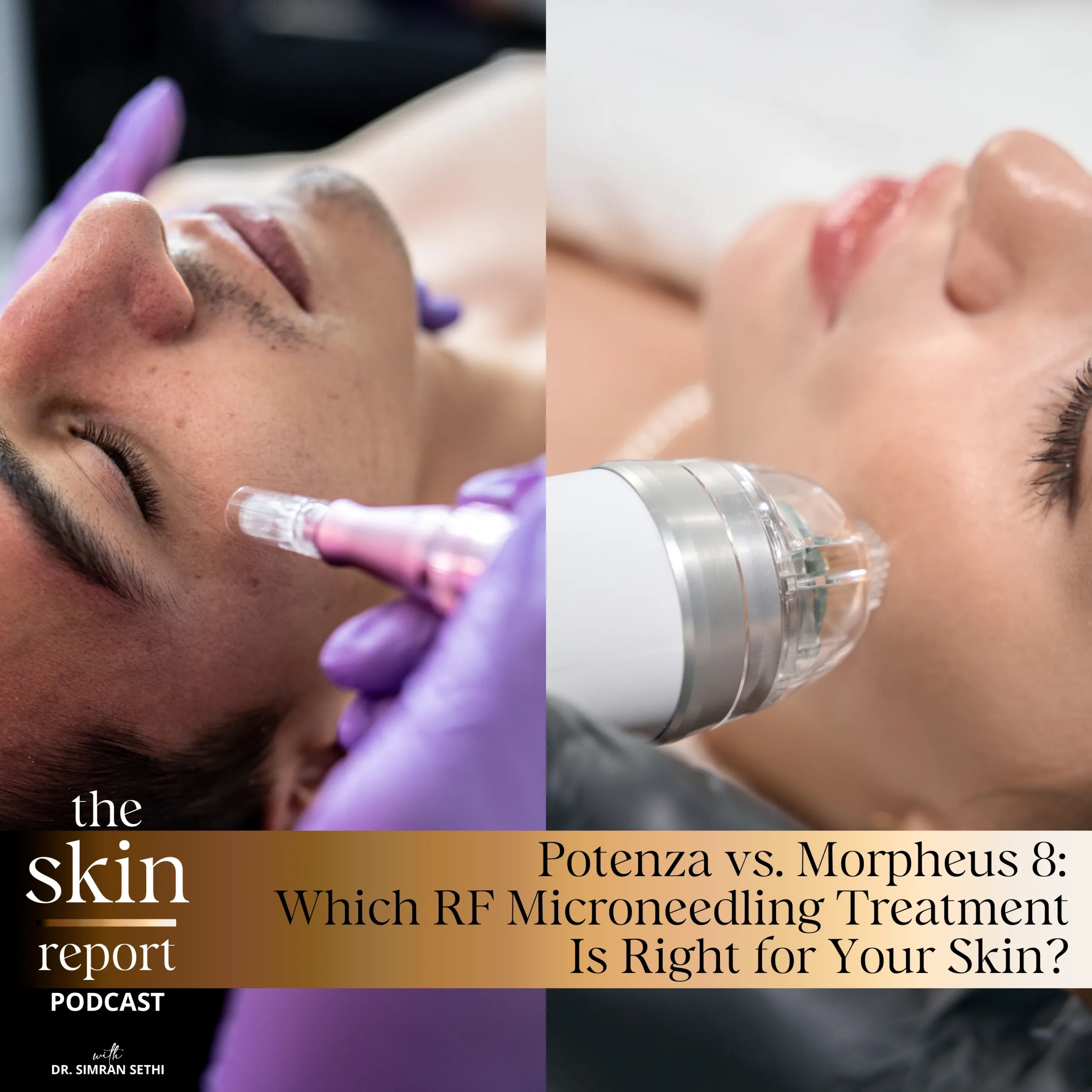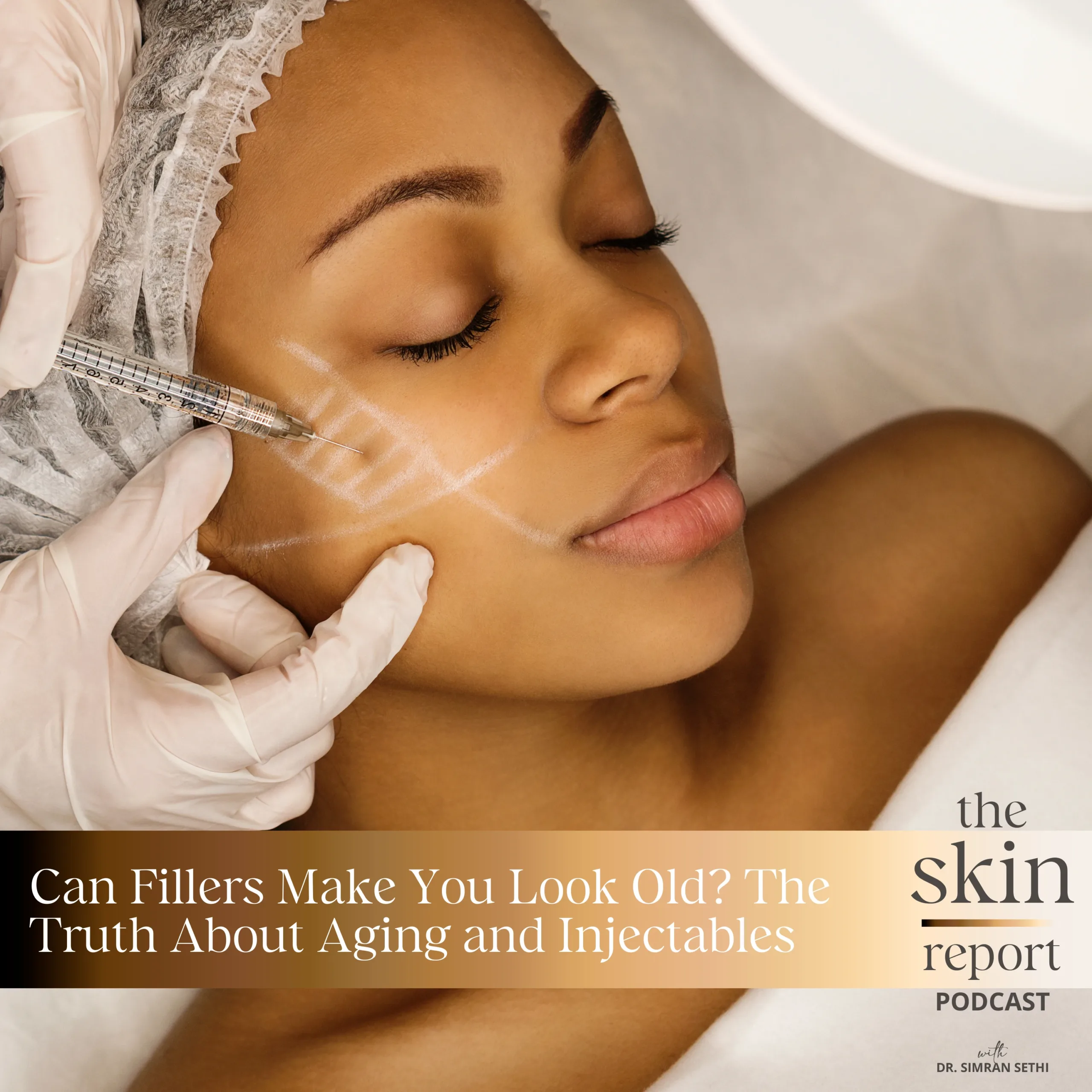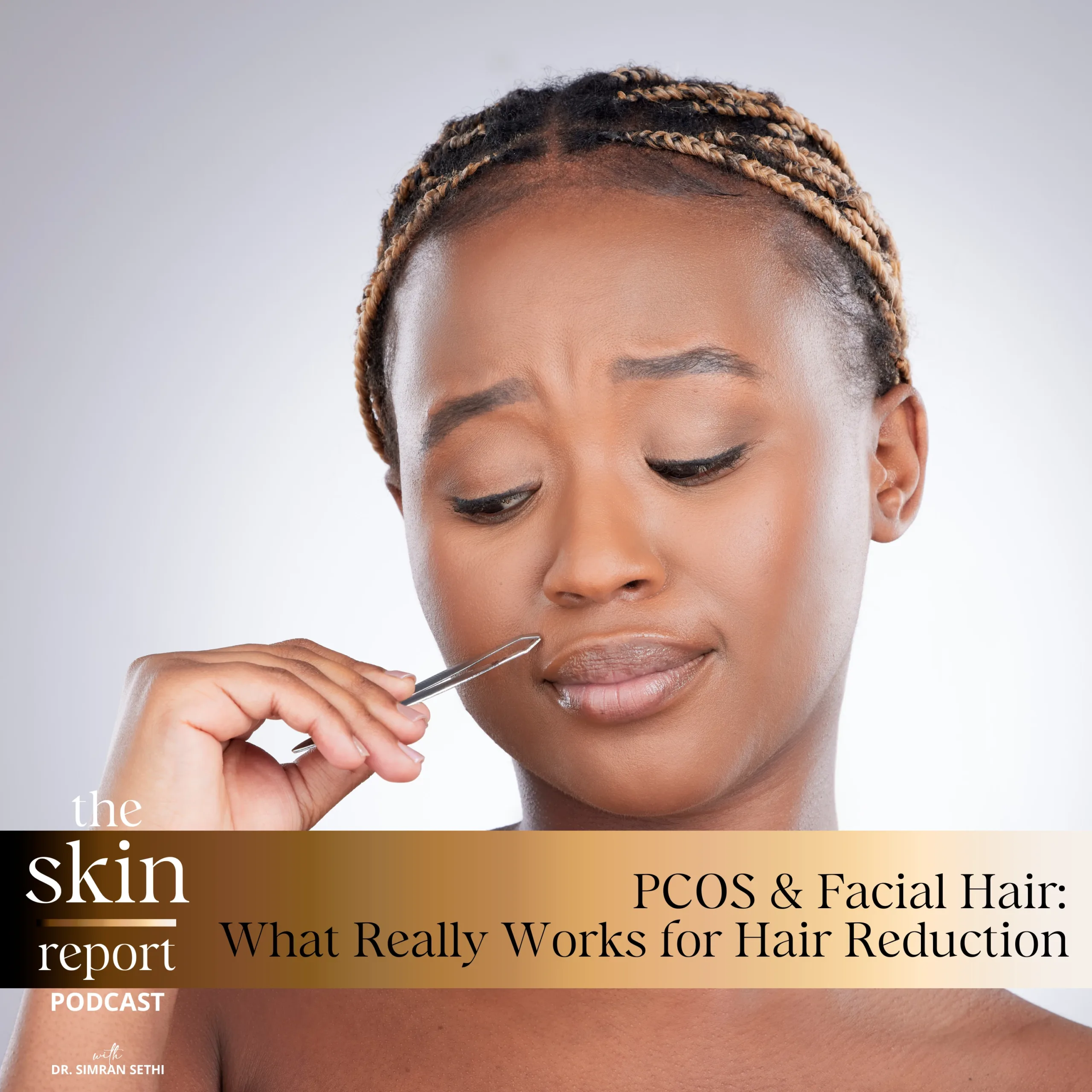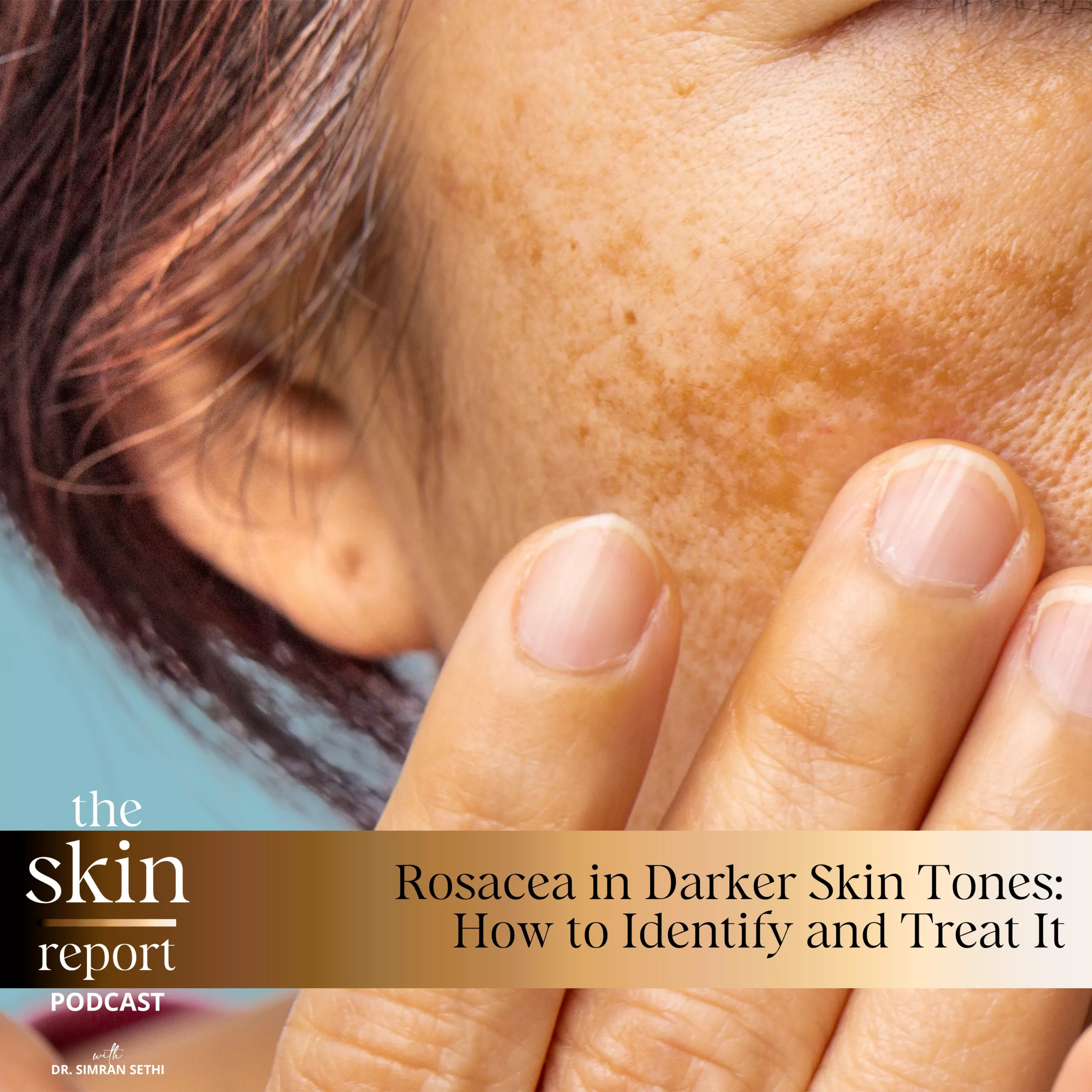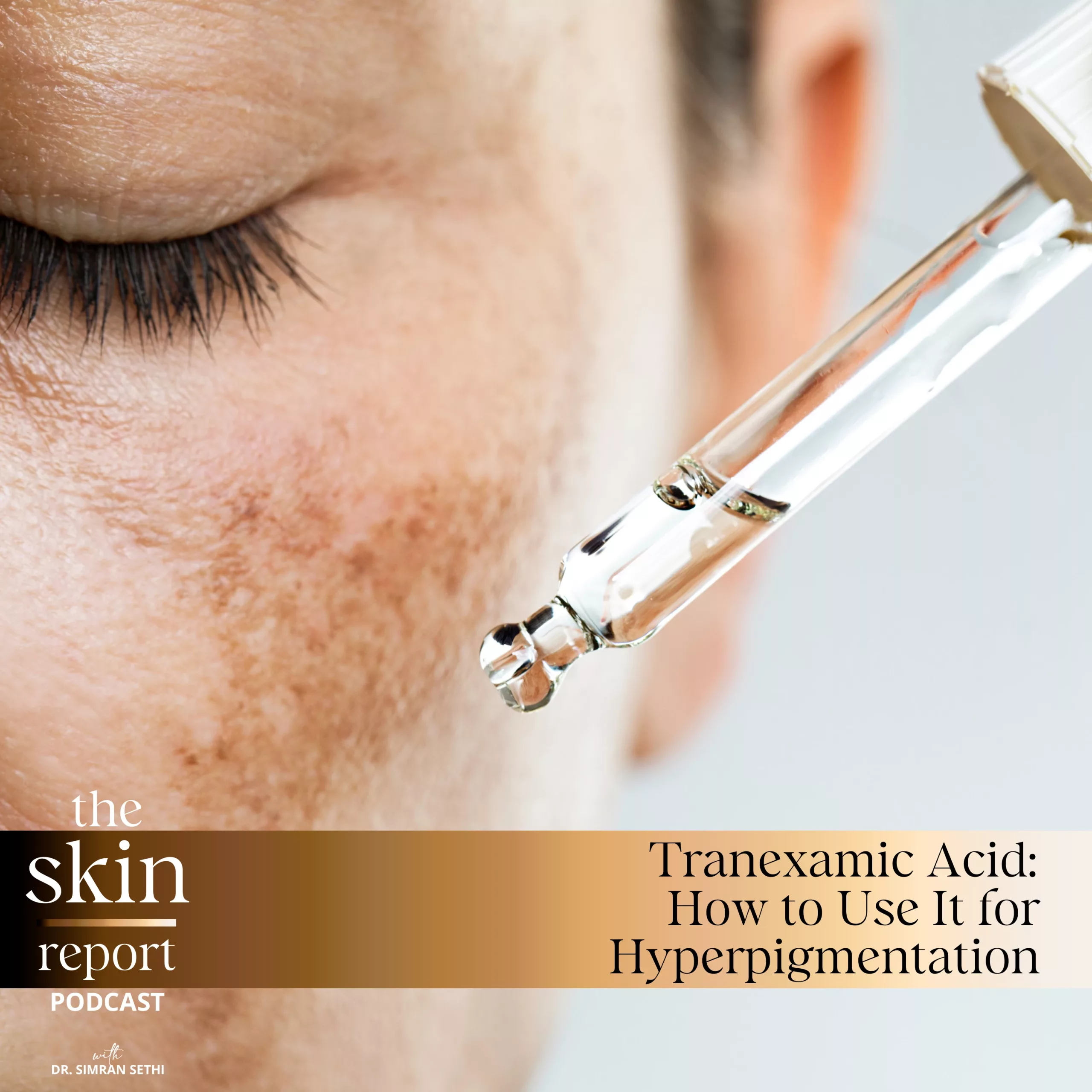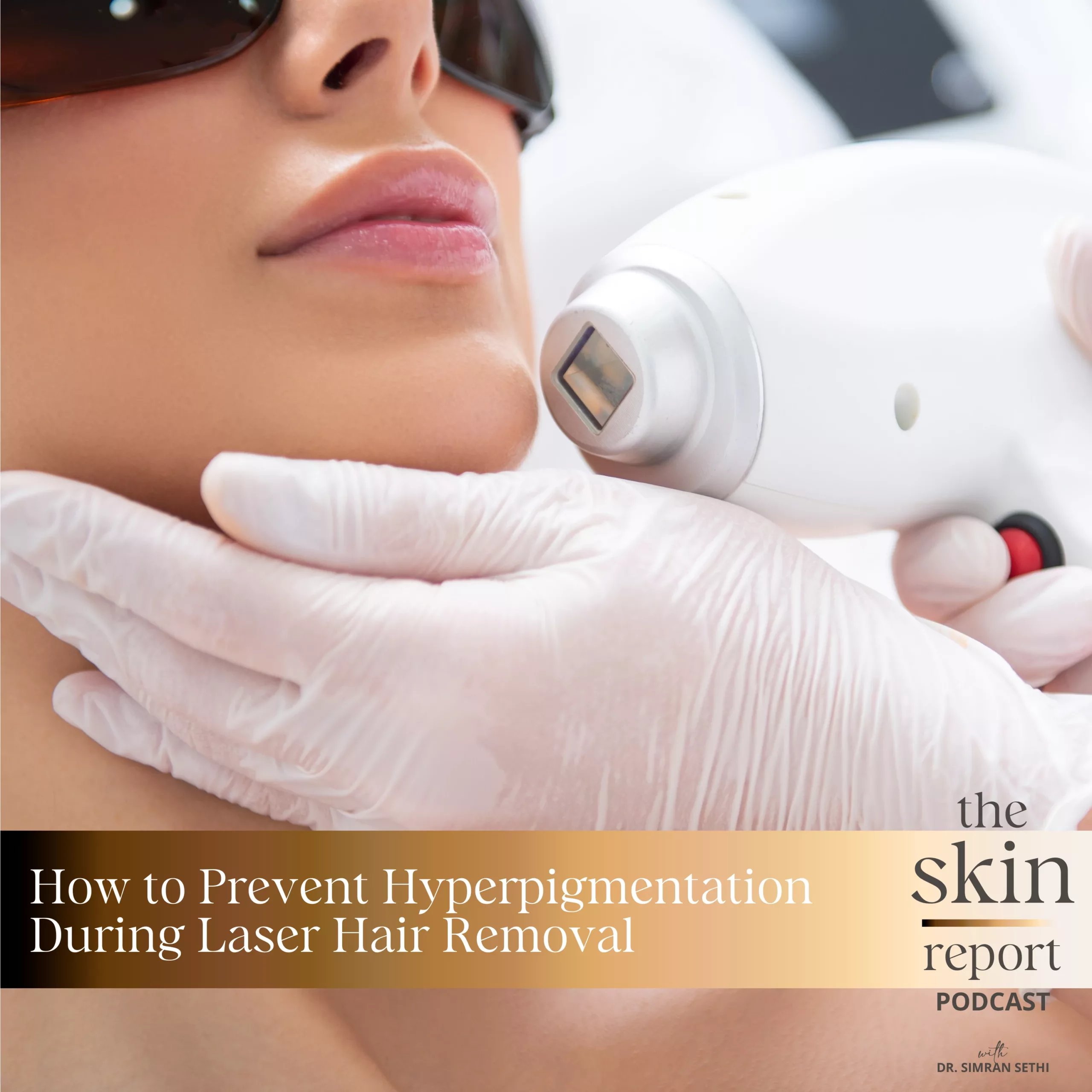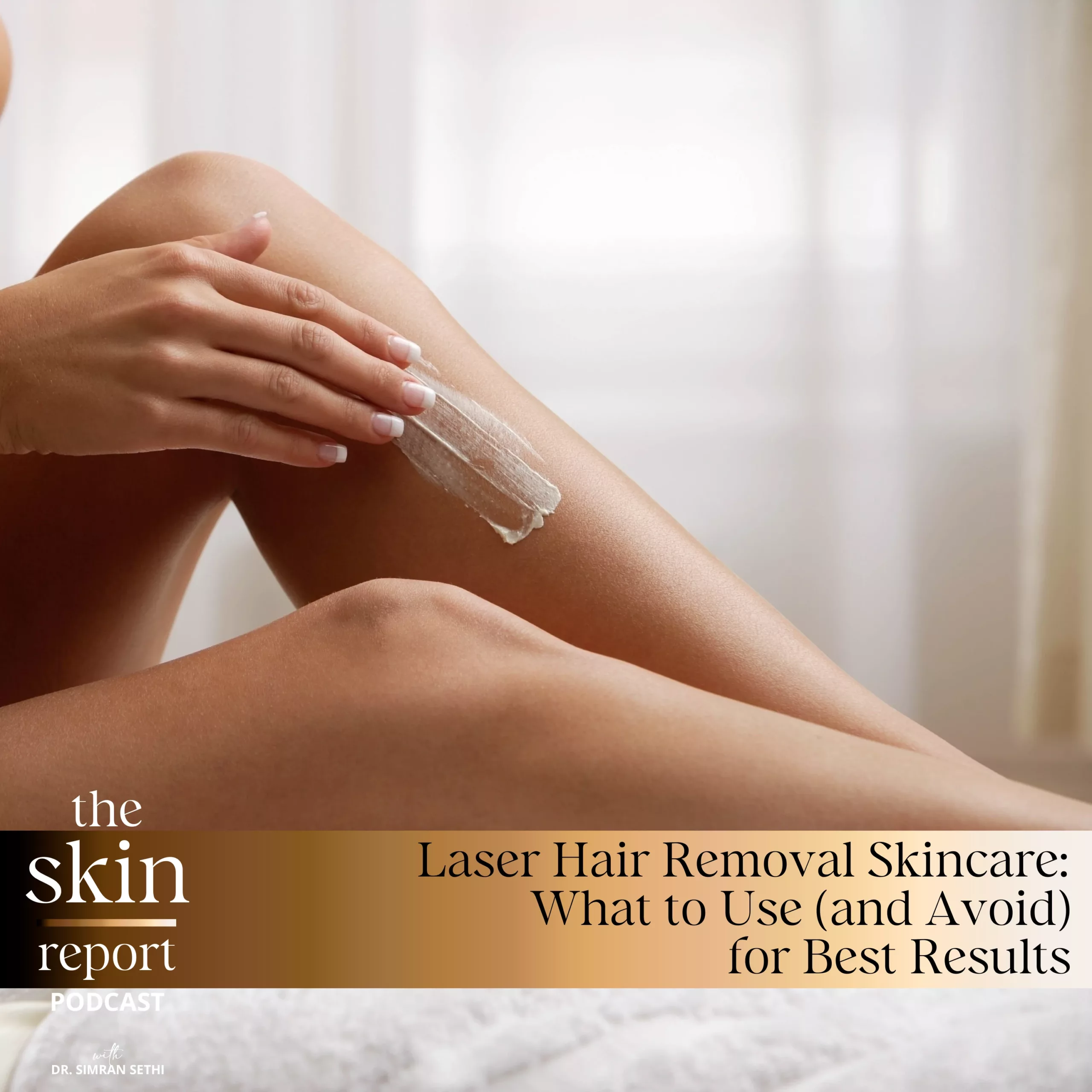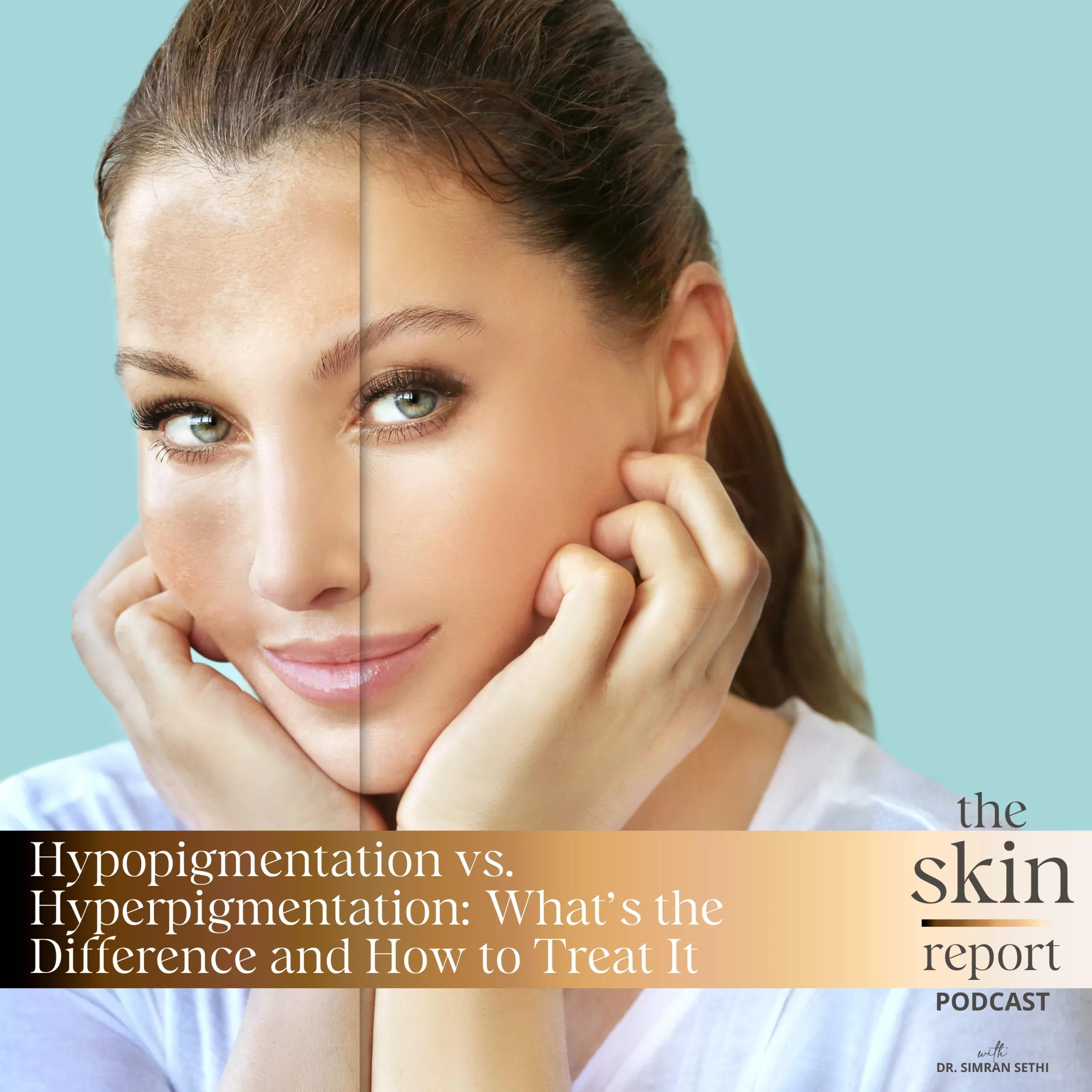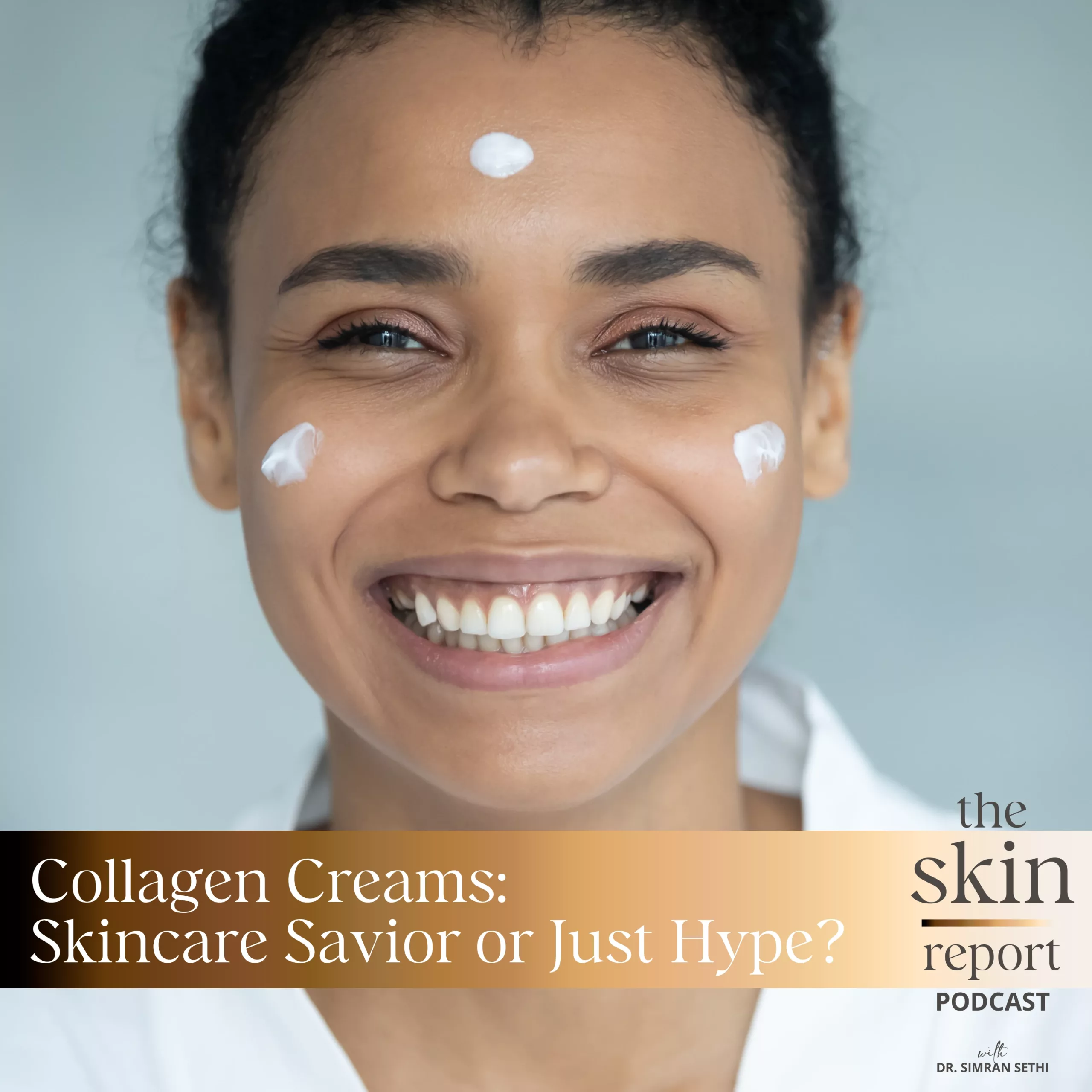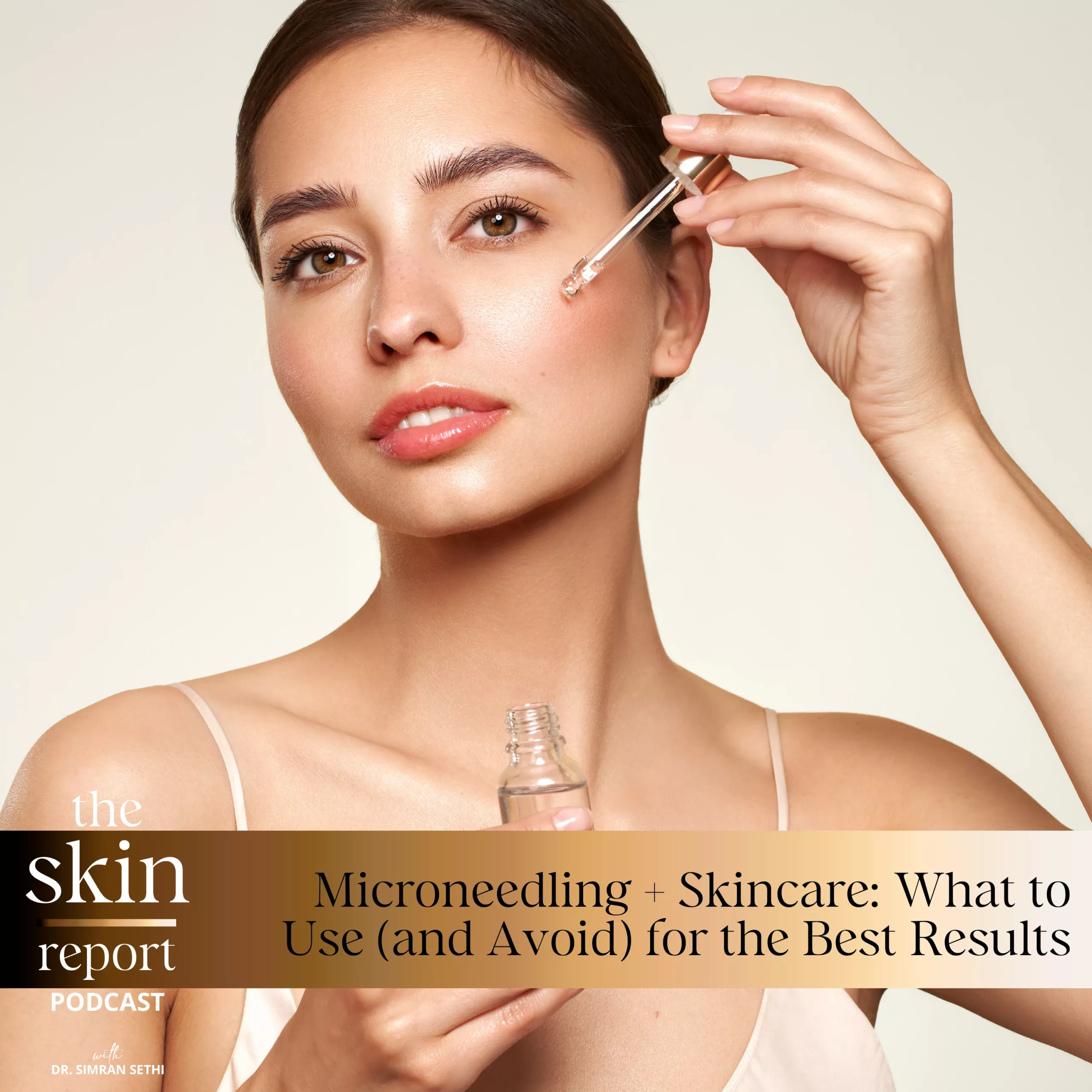As the temperature and environment around us change in the winter months, so does the care that our skin requires. Many people can be impacted by the dry winter air, causing irritated, red, itchy, and flaky skin. For dry skin, mature skin, and people with conditions that weaken the skin barrier, it is important to support the skin’s moisture in the dry, cold months. Therefore, applying seasonal skincare changes is important to ensure your skin’s health and beauty.
The Skin Report is a podcast created to educate listeners on methods to improve skin health for people of all ethnicities and ages. On this episode, host Dr. Sethi discusses the best winter skincare methods, routines, and products for different skin types and tones. Dr. Sethi teaches listeners about the best practices for exfoliation, cleansing, moisturizing, and other skincare methods in the wintertime. She also tackles the most popular products on winter skincare lists online and on Tiktok and shares her insight on the best ingredients to incorporate into a winter skin routine. So tune in to learn how to care for your skin this winter season and for years to come!
Follow and DM a question for Dr. Sethi to answer on The Skin Report Podcast:
Renew Beauty Instagram:
https://www.instagram.com/renewmd_beauty/
RenewMD Beauty Medical Spas, California:
https://renewmdwellness.com/
The Skin Report – Preparing Your Skin for the Summer:
https://theskinreportbydrsethi.com/season-1-episode-8-preparing-your-skin-for-the-summer/
The Skin Report – Coconut Oil: Helpful or Harmful:
https://theskinreportbydrsethi.com/season-1-episode-15-coconut-oil-helpful-harmful/
Byrdie – Best Winter Moisturizers for Dry Skin:
https://www.byrdie.com/best-winter-moisturizers-for-dry-skin
Glossy – CeraVe and E.l.f. Cosmetics rank as top beauty brands for Gen Z:
https://www.glossy.co/beauty/cerave-and-e-l-f-cosmetics-rank-as-top-beauty-brands-for-gen-z/
National Library of Medicine – Sebaceous gland lipids:
https://www.ncbi.nlm.nih.gov/pmc/articles/PMC2835893/#:~:text=Human%20sebum%20consists%20of%20squalene,%25)%20and%20squalene%20(12%25
This transcript was exported on December 27, 2022 -view latest version here.
Skincare can sometimes feel overwhelming. Whether it’s finding the right products, ingredients, or treatments, there’s a lot out there, but not always for people of African, Hispanic, Middle Eastern and Eastern South Asian descent. That’s why I set out to educate myself and others so that we can all feel beautiful in our skin.
Hello and welcome to The Skin Report. I’m Dr. Simran Sethi, an internal medicine doctor, mom of three and CEO and founder of Renew Empty Medical Spas and Skin by Dr. Sethi. It’s now December, which means it’s that time of the year. Whether you’re celebrating Hanukkah, Christmas or Kwanza, you are doing some holiday shopping. If you’d like to hear my advice on which skincare gifts are worth the money, tune into episode 29 of The Skin Report. For today, however, I want to talk about something that you can use beyond just December. Not just for this winter season, but years to come. I want to talk about the best winter skincare routines and products for different skin types and tones. So let’s jump in.
Your skin needs are not always the same, they evolve as you do. No matter your age, you likely would benefit from addressing your skin needs with the changing seasons. In July this year, we released an episode called Preparing Your Skin for the Summer, in which we discussed ways to give your skin a little extra love during humid hot days. A few months later, and now we’re entering the drier colder season, which means our skin gets dry. In fact, so many people can be impacted by the dry air that the term winter rash has emerged to describe irritated red, itchy, flaky skin. Some patients may experience such severe winter rash that they seek out medical treatment to help. According to a 2019 survey by OnePoll and Survey, 60% of the 2000 American participants reported unhealthy winter skin. There are plenty of articles and videos uploaded around this time recommending different routines and products to help avoid this. I want to take a look at some common themes I agree with and some that I don’t, so that you can be informed.
Our skin is constantly making new skin, which means we have a layer of dead skin cells sitting right on top of it. This layer can make our skin look dull, but more importantly, it can prevent our skincare products from fully absorbing into the skin when applied. If you were exfoliating daily in the summer, consider reducing this to every other day or a lower strength. While we need to exfoliate, it has to be done with a fine balance in order to maintain our skin barrier. In season one, episode 14, we discussed types of exfoliants. To quickly recap, if you are using a physical exfoliant, opt for ones that use oat or rice bran to help polish off the dead skin cells as these small particles won’t cause micro abrasions on the skin. If you are using a chemical exfoliant with active ingredients such as AHAs or BHAs, that will dissolve the dead skin, try for a lower concentration.
This is especially important for skin of color. Skin of color should always aim to use either a small particle, physical exfoliant, or a low concentration chemical exfoliant as harsh, stronger products can cause hyperpigmentation. I highly recommend listening to or revisiting the exfoliant episode as your skin may need something different for the dryer months ahead. You can find the link to that episode in the description. Now I want to mention a few groups who should be extra conservative with their exfoliating routines and products. Those groups are people with melasma who have a weaker skin barrier in the area where their excess pigmentation patches are. I would highly recommend being gentle with melasma afflicted skin, and opting for a botanical chemical exfoliant or a very small particle mechanical exfoliant that are gentler, and these can only be used once or twice a week. This approach will keep the already weak skin barrier intact. People on Accutane or those who have completed their Accutane treatment in the last few months.
Accutane is a frequently prescribed oral vitamin A that eliminates acne in patients with severe acne. Accutane is very effective at eliminating acne, but it does leave skin very, very dry as it disrupts the skin barrier. Those with eczema as eczema also weakens the skin barrier. Patients who have just had a medical grade skin resurfacing procedure. Medical grade procedures break the skin barrier to initiate a healthy and stronger repair of the skin. However, this process starts as soon as the procedure is performed and it takes a few weeks for the new skin barrier to rebuild. Most skin laser or micro needling procedures are performed in a monthly series of four to six sessions, so if this falls in the winter, exfoliating should only be done no more than two times a week. People who just got a chemical peel. Chemical peels generally have to break the skin barrier so that the chemical can attempt to penetrate deeper into the skin.
As with medical grade skin resurfacing treatments, those who have done a chemical peel should only exfoliate two times a week until their skin has recovered, which usually occurs about a month into the chemical peel. Onto another aspect of skincare, one that is extremely important, especially during the wintertime, moisturizer. Even if you use a moisturizer in the warm seasons, switching to a more lipid rich or thicker formula may be required if you have dry, sensitive or mature skin. A thicker formulation that includes things like linoleic acid or avocado oil are examples of lipids that can nourish the skin and build a lipid that normally make up the skin barrier. Now, there can be a lot of misinformation on the internet this time of the year. I want to share some trends and bad advice that I do not recommend so that if you come across them, just keep scrolling.
The first one would be washing your face in the morning. It is important to wash your face with a cleanser every morning because just like the rest of your body, skin follows a circadian rhythm and actively grows new skin cells in the skins deep dermis at night. This also means that older skin cells are pushed up to the skin surface to slough off. If you don’t wash your face in the morning, which is a popular social media trend, and a lot of my patients ask me about, the dead skin cells and debris may just clog your pores, regardless of skin type. So remember, always wash your skin in the morning, no matter if you have dry, oily, combination or sensitive skin. To maintain moisture on your skin in the winter, choose a cleanser that is cream-based and hydrating, no matter what skin type you have. Avoid cleansers with AHA or BHA if you have dry, sensitive or mature skin.
The same is true for the skin conditions I mentioned earlier in regards to exfoliants. Another trend I’ve seen is applying coconut oil or high molecular rate oils on your skin. While using products with oils in it like lipid ridge moisturizer is great for the winter, applying oils directly to the skin is not. Larger molecular rate oils have a difficult time penetrating into the skin if applied directly. However, when properly formulated with other compounds in skincare, their absorption improves. Additionally, if you don’t wash your face and then directly apply an oil on your skin, you are definitely promoting clogged pores and breakouts. I see a lot of people doing this and in darker skin tones, these breakouts lead to long-standing pigmentation too. We dive deeper into coconut oil in episode 16. So if you’re curious about the ways we can actually use it to our benefit or not, you can find the link to the episode in the description.
So what can we do instead? As you may have guessed, moisture and skin barrier protection are key in the winter months and therefore should be the focus of our skincare routines. The following routine is advisable for all skin types and tones with a few exceptions. The morning routine. Step one, cleanser. A moisturizing or hydrating cleanser that will not strip your skin of oils. Step two, an antioxidant-rich serum like vitamin C or green tea serum. Just like any part of the year, you are still getting exposed to things like pollution, sun and blue light, and therefore need an antioxidant to fortify your skin proteins. Sometimes when people add or up their moisturizer, they stop using serums. However, these products have separate functions. I’m a huge fan of layering your skincare with effective products instead of relying on one cream to do it all. Using those five in one products won’t deliver all the active ingredients needed to nourish the skin renewal cycle.
As we’ve discussed before, using more of one product does not necessarily make it more effective. So no matter how much of an all-in-one product you apply, it’s a waste of your time and money in the long run. Opt for effective items with active ingredients you know will make a difference to your skin’s health and appearance. Step three, moisturizer. No matter if your skin is oily, combination, normal, dry, or sensitive, using a moisturizer in the winter is an important step for all skin types. If you have dry or sensitive skin, opt for a thicker formulation. All of these steps are pretty standard, but our next step is a little more complicated and less known, so I want to take the time we need to explain it. For step four, I highly recommend a high potency hyaluronic acid serum. This is a less known essential and one of the staples in all my skincare lines kits.
We are warm body, which means we are constantly losing moisture to the air. I’ve gone over the pot of water analogy before on the podcast, but I just want to reiterate it here, especially considering how important moisture is in the wintertime. Think of a pot of water simmering on the stove. After a while, all the water in that pot will eventually evaporate into the air and the pot will be empty. Our body and skin are that pot and no matter how much moisturizer we apply, we will continue to lose that moisture throughout the day unless we apply a moisture barrier which locks in the moisture. Hyaluronic acid is an excellent moisture barrier for all skin types, dry, oily, combination or sensitive. Moisture locking will keep your skin plump and in darker skin tones, it’ll actually make the skin more even toned.
The alternative is to keep filling the pot with new water as it evaporates, which would be like applying moisturizer on constantly. We can do this, but this is often not realistic while we are busy throughout the day. So instead, creating an effective moisture barrier is a way to keep the skin hydrated by working smarter, not harder. Now, before I go to the final step in the morning skincare routine, I would like too quickly address a popular TikTok trend that attempts to address moisture locking, but does so in a way that is not realistic and is likely damaging your skin. Skin slugging is a trend that recommends applying petroleum jelly or Vaseline on top of your skin to protect moisture from evaporating off the skin. Yes, petroleum jelly will seal in moisture, but it will also clog your pores, especially if you do not exfoliate properly or have acne prone skin. Your skin loses most of its moisture during the day, and if you apply petroleum jelly on your skin, it will look very greasy and prevent you from applying products like sunscreen or makeup properly.
Finally, there are better options to protect moisture on your skin, so why not use them? Apply a highly concentrated hyaluronic acid serum above your moisturizer that will sink into your skin without making it look greasy so that you can protect your moisture and skin barrier throughout the day and night. The last step in the morning skincare routine applies to everyone of all ages and ethnicities. Step five is wearing sunscreen. Although the days are shorter, the suns rays are still strong in the winter. If you live in a climate with a lot of sun, you’ll actually get more sun exposure than if you lived in a place like sunny California. Why is this? Well, white surfaces reflect suns rays, not absorb them the way black surfaces do. This means that when the suns ray hit snow, they bounce back up and will hit your skin from all directions as opposed to just from above.
This is why people can suffer moderate to severe sunburns if they don’t protect themselves in the snow. In fact, if you have melasma, a ski vacation is all it takes to exacerbate it or sometimes trigger the first presentation of melasma. Even in the winter, you still need to wear an SPF of 30 or above. Now I want to quickly mention what a night routine may look like. For the night routine, you would repeat all the steps except sunscreen, but consider exfoliating at least two to four times a night on a weekly basis after cleansing. If you’re using a retinol, you should include this in your PM routine after applying your serum. You can then apply your moisturizer above the retinol. Be sure to check out my YouTube channel where I share all of my episodes plus bonus content.
Thank you for sticking with me during this episode. I know we are covering a lot. For this episode, I’ll break down the top moisturizers on winter skincare lists and TikTok. Some top products I feel have great ingredients to not only moisturize the skin, but also deliver other benefits like inflammation reduction or peptides for collagen production. So let’s take a look at the products mentioned by Birdie.
The Augustinus Bader Rich Cream and Biossance Squalane and Gel Probiotic moisturizer make it to the top of the list for good reason. Both contain an ingredient called squalane, which is similar to squalene. Squalene is naturally found in human sebum and is secreted by the body to protect the topmost skin layer. We know this from multiple studies, including ones published in the National Library of Medicine. So both of these products contain squalane, which is a derivative of squalene. This derivative is used in skincare so that it can be more stable and have a greater shelf life. Both products contain primrose oil and seaweed and ginger extract respectively, which help reduce irritation. Overall, these are great products for anyone with dry irritated skin, and can help support the moisture barrier for the group of skin conditions like melasma and eczema, as I mentioned earlier. Two popular products that come up in various skincare sites are the Charlotte Tilbury Magic Cream and Neutrogena Hydro Boost Water Gel, which also appear on Birdie’s list.
I like that both these products contain hyaluronic acid, but only Charlotte Tilbury’s Magic Cream contained rosehip oil, which adds more moisturizing lipids. Between these two, I would suggest anyone with dry or mature skin to opt for the Charlotte Tilbury Magic Cream. For those with oily skin, I would pick up the Neutrogena Hydro Boost as it is not rich in lipids. Finally, a product or brand that is very, very popular on TikTok and according to Glossy, is 2022’s top skincare brand, is CeraVe. For the purposes of this episode, we’re going to talk about the CeraVe moisturizer. CeraVe is commonly recommended by dermatologists because it is safe for baby skin and will not irritate the skin. As it’s more geared towards baby skin however, it does not contain any ingredients that promote healthy collagen growth. Additionally, it has a high content of petroleum jelly or Vaseline, which can actually clog pores.
Last week, we did a deep dive on retinols and what they can do for our skin renewal cycle. In that episode, we also examined how the rate at which our skin produces new cells declines with age. So babies and young children have a high rate of skin cell turnover and products like CeraVe are great as a gentle moisturizer. If you are not a baby or young child, CeraVe would not be my go-to choice, as it does not include ingredients like peptides, which promote collagen production. Using products with peptides and lipids can help strengthen skin and make it appear and feel younger and softer. I know dermatologists frequently recommend CeraVe, but honestly, they do so for a short period of time to help rebuild the skin barrier in young patients and in patients who have over-processed skin. Using CeraVe in the long run or for months provides limited benefit, and given that we have so many amazing products to choose from, there are other potent formulations to moisturize, calm and rebuild the skin.
If you’re looking for a great winter moisturizer, I would check out the products previously mentioned. If you’re in need of a moisture locking product, I would take a look at my AHA Plump and Protect to apply above moisturizer in all skin types. Skin of color is especially prone to hyperpigmentation and uneven skin tone, so moisture locking is important in darker skin tones, no matter how dry or oily they are. The AHA will balance and protect moisture in the skin, which will even the skin tone out. It also has snow mushroom extract that holds onto thousand times more water than AHA alone. If you want to pick a moisturizer from my collection, I like the UltraGlow Moisturizer for all skin types, including people with oily or combination skin. The UltraGlow Moisturizer has two brightening proprietary antioxidants, lipo chroman and chroma bright that keep the skin’s moisture barrier strong and in turn, eliminate uneven pigmentation that is common in dehydrated skin.
Finally, it also contains peptides that promote collagen production, which is an important consideration for anyone in their thirties and above, as our collagen production starts to slow down in that age group. For dry skin or mature skin, I like to add the Vitamin E&F Serum for extra lipid boosting. This formulation is rich, but it seeps right into the skin so that your skin feels hydrated, not greasy. I hope this episode was helpful for you and will help you achieve or maintain your glowy skin no matter how cold or dry it gets out there. Thanks for listening, and until next time, love the skin you’re in and celebrate your beauty.
If you’d like to learn more about science-backed skincare or medical aesthetic treatments, please subscribe to and turn on notifications for the Skin Report, so you always know when a new episode is up. We have a newsletter that you can sign up for on theskinreportbydrsethi.com so that you can stay up to date on all our new episodes, blogs, products, and more. Additionally, if you have a skincare question or want to make an episode topic recommendation, please message me at theskinreportbydrsethi.com. We’ve received some great questions so far and I’ll try and answer them at the end of every episode, so keep them coming. Thanks for listening, and until next time, love the skin you’re in and celebrate your beauty.
Transcript by Rev.com


